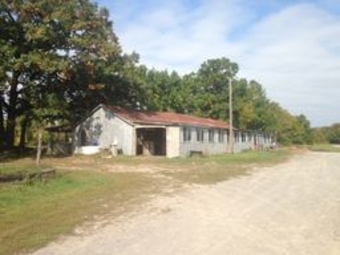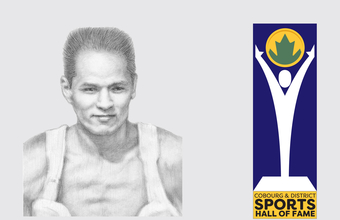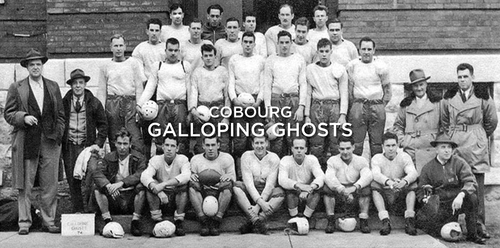Harness Racing-Gord Sherwin
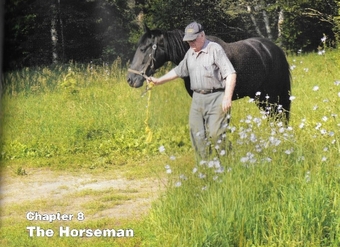
Gordon Keith Sherwin
The Horseman - By Gary May
Reprint Chapter 8 from “A Life Well Travelled” ‘The Story of Gordon Keith Sherwin’
Permission of Publisher ‘Your Story Publishing’ 2010 – Windsor, ON
Racing standardbred horses can be a dangerous sport. Gord Sherwin has had his share of injuries over the years, from having both shoulders separated, to breaking his leg. And there have been plenty of close calls, like the time he was tossed over a racetrack hub rail.
But working with any large animals comes with its dangers, Gord says philosophically. It's all a matter of taking care and knowing when to call a halt.
Gord’s career with standardbred horses began, naturally enough, through his trucking business, when his Baltimore friend, Jack Ball, asked him to haul his animals back and forth to fairs. His career as a horseman reached a zenith when he was named the 1986 Man of the Year by Harness Horsemen International.
Gord still hangs on to a couple of pacers at Grasshopper Flats, a private track near his Baltimore home that’s owned by old friend Cliff Hie. Gord begins each day with a five-minute drive out to the track barn in his 1993 Chev pickup to water and feed them, then leads them out to a paddock where they get their exercise. He mucks out the stables and gives the horses fresh hay. Then it's back in the afternoon to feed and water them again.
There's a dusty old radio in one corner of the barn. Gord leaves it tuned to the local classical music station, occasionally adjusting it up or down for his charges, Fiddlers Dream and King of the Clan. They seem to enjoy the soothing music, he says. But his training and riding days are behind him. "I just don't really feel much like doing it anymore."
When pressed, he will, reluctantly, talk about the various injuries he's suffered from working with the animals, starting back in the late 1950s.
Risky Business
"Once, in the barn I hadn't locked the door properly. I hear a click of a hoof on the cement. The horse is loose. I grab him. He knocks me down and steps on my leg."
Gord does not get it immediately looked after and continues with plans to help out at the Rotary Waterfront Festival in Cobourg. Luckily his physician daughter, Elizabeth, happens to be coming for the weekend. "She takes one look at it and advises an X-ray. I had a fracture in the lower leg. Here I'd been taking admission at the festival gate on a broken leg."
The worst spill he ever suffered came on the track at Orono.
"My horse stumbled. I ended up thrown over the hub rail."
"You've got horses going at top speed. All it takes is a minor misstep and you're in trouble. You could have a field of 10 horses. They go one mile in a minute and 48 seconds nowadays. When I started I’d win races with 2:08. Now under two minutes is normal”. (At two minutes a mile, the horse is averaging 30 miles an hour). "I think faster times are a result of better track conditions, lighter bikes and training methods."
So back in the '50s, Gord began hauling Jack Ball's horses for $5 a trip. It was enough, he says, to get him hooked. "When I started, we were just a bunch of farmers having fun. I remember seeing the Gary Cooper film, Friendly Persuasion. He was Amish. Had a buggy horse. Took his wife to church and his neighbour challenged him to a race each week. He picked up a pacer with good speed. One week the neighbour's waiting for him and challenges him to a race. The pacer leaves the old guy in the dust."
Gord chuckles. "That's the way it was with us, a bunch of old farmers raising, training their own horses." Gord began driving and racing horses before he ever owned one. "Jack Ball owned the Baltimore Mill, had a stable of horses. He got me involved with them. l used his cooper's shop down in the village as an office and a storage place. Kept my trucks there until I built a garage here at the house. That place was kind of like the local Hot Stove League. We'd play a little cribbage, gab with the local boys."

Gord got his driver's licence for horses in 1957.
"I'd been around Jack's horses, and driving them. We’d train them together. Better to train a couple or three together - they learn a little bit from one another. What they're bred for. They provide a little competition for one another. The first Saturday of June every year, they'd have a field day at the local race track. The races were recorded on the horses' racing record. I raced one of Jack's horses. Bud Phonograph. I ended up owning him a couple years later for a thousand dollars. But my first horse was Sun C Valley. She was a chestnut mare with a white blaze on her face, white feet. A classy-looking mare.
"When I first got started, they'd race once a week at Peterborough Exhibition Grounds. 'They had twilight meets. They didn't have lights. One of the first tracks I went to was the fairground at Norwood. I didn't drive there, but I was hooked by then; got my licence after that. Every community of any size had a fairground and there was a racetrack on the fairground, because that was part of the fall fair experience, standardbred racing. Then they started to put up lights so you could race after dark. Peterborough was one of the first to put up lights. Then Belleville did it.
"They started having a race every Friday night at Belleville, and then in Peterborough on Saturday night They were just local guys you were racing against. People from Warkworth, Campbellford, Marmora, Norwood, Lindsay, Port Hope, Orono.
"These places all had local horsemen, and it was really the grassroots of standardbred racing. It’s difficult to explain the satisfaction you get raising a horse, breaking it in, racing it and winning with it. I've had quite a few experiences with it.”
"I remember Saturdays spent at the race track in Peterborough," says Elizabeth. "As a family, we didn't have a cottage and we didn't do a lot of travelling. Every Saturday was going to the racetrack. Diana and I always wanted to go to Peterborough early so we could go to the material shops, because we did a lot of sewing. And Dad would say he'd be home in time.
“We would wait and wait and he'd always be late," she laughs. "He was busy. That would be disappointing, but that was what the business would require at that time."
Arts & Battles
Perhaps the most exciting horse Gord ever owned was one that didn't reach his potential until a winter on the Florida circuit. But when he did, says veteran trainer and driver Doug Hie, Cliff Hie's son, he showed more heart than just about any other animal Hie has ever known. No horse Gord owned over the years meant more to him than Arts & Battles. Sired by Meadow Battles, a top winner from the late 1950s and early '60s, out of Gord’s own brood mare Tar Peg, Arts & Battles was raised and trained by Gord from the time he was a foal.
The horse was named for his sire, and for horseman Arthur Beedham, who boarded him. In the late 1960s, "I started taking him to races and he became a top racer around Peterborough. He became the one to beat in his day.”
In the early '70s, Jay was attending Queen's University and already possessed a driver's licence. Gord asked him to run the horse one night at Peterborough. Gord couldn't go because he and Marion were committed to another event. 'When Gord arrived home that night, he asked Jay how things had gone. Jay smiled and presented his dad with a tape of the race. "We won," he said. "It was quite a thing for a young fellow like that to win," says Gord proudly. "He was pretty excited. Arts & Battles was a good horse. Had stamina and speed. He was always competitive."
While Gord frequently raced the horse himself, he would also call on Doug Hie to race him. Doug had a stable, track and exercise pool, which was a helpful tool in training horses without placing· so much stress on their tendons. Arts & Battles had suffered from tendon problems from an early age, and never seemed to achieve his potential - at least until Hie offered to take him on the Florida circuit one winter in the early '70s. Hie entered him in a lower-level competition at Pompano Park, and the horse won. Hie entered him again, and again Arts & Battles took the field.
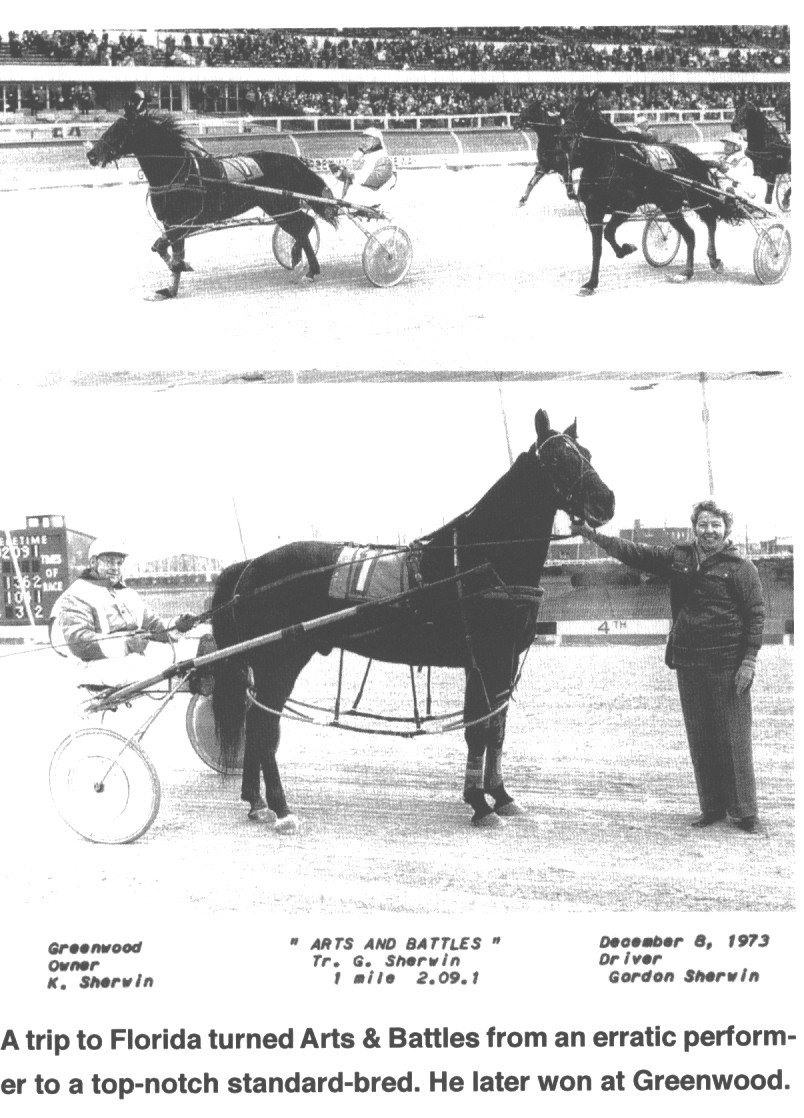
"I turned him around in the winner’s circle and he got a standing ovation from the grandstands. I couldn't believe it. They were clapping and whistling. Everyone was standing. It just blew me away."
Hie called Gord to tell him Arts & Battles was going to receive the track's Presidents Award that year and Gord and Marion arranged to head down for the celebration. The day before the ceremony, Gord took in a race.
"On this occasion, he lost," says Gord, "but he was so used to winning that he turned around to go into the winner's circle and wait for his picture. The crowd saw this and reacted with a standing ovation." Gord's pride soared.
After the winter season, Gord entered the horse at Saratoga, New York. He and Marion chartered a small plane and flew to the track with Hie. They won. "The whole experience was quite a thrill," says Gord.
Back in Canada in 1973, Arts & Battles took half a dozen races at Greenwood, then considered the top standard-bred track in Canada. The next winter, Hie took Arts & Battles back to Florida and he won two of his first four races, placing second and third in the others. Then tragedy struck. The horse's tendon problems returned and this time, nothing could be done.
It was the end of racing for Arts & Battles, although he lived out his days with a man in Bobcaygeon who was delighted to obtain a horse of that calibre to pull his buggy.
“That was a horse that stands out in my mind," says Gord.
Adds Hie: "That horse had personality. He was cocky. He was a standout in my memory," says the man who has been racing for more than 40 years.
So, what happened to turn around the career of a horse that had earned only about $22,000 in his first five seasons? How was it that in his first winter in Florida he chalked up $40,000 in winnings?
"He was a totally different horse in Florida”, says Hie. “His legs were bothering him in Canada. I tried different training methods. I swam him in the pool and that really helped. He loved the pool. He always wanted to pass the other horses in the pool. He wanted to beat everybody.”
The Quinte Jug
Another one of the highlights of Gord's career as a horseman came in 1986 at the Belleville fairgrounds' Quinte Jug race, a takeoff from the Little Brown Jug, a top U.S. standard-bred competition. "There are eliminator races over several weeks to get down to a field of about seven. I had two horses, Bell Jet Ranger and Amboseli (named for an African game preserve). They were three- and four-year-olds. Jay drove Amboseli. It was a photo finish for one and two spots.
"As the judges were deciding between the two, and it
was so close, someone said, 'it doesn't really matter, because the same guy owns them both.' That was quite a thrill."
In 2010, Bell Jet Ranger was 26 years old, and living a life of leisure at Jay's home. She's the mother of Gord's current horses, Fiddlers Dream and King of the Clan.
Gord unloaded Amboseli at a claiming race for $30,000. Standard-bred racing is rarely a money-making pastime, says Gord. He lists the fixed costs of owning· a horse: $60 a week for feed, $20 for hay and $20 for bedding, plus utilities.
He fondly lists off the other horses he's owned over the years. Jimmy Bellwin, Judicator, Robbie McGee, Colonel Philip, Call Me Spud, Mount Kenya, Roda's Angel, Shamaldas, Thebes, Dream Cast, Beautiful Sunday. (Just like Amboseli, Shamaldas and Judicator were eventually sold in claims races and went on to race for their new owners.)
CLAIMING RACE:
At a claiming race, the owner places a value on his or her horse and enters them in the race with other animals of similar value. Interested buyers file their claim amount and their name is placed in a locked box. After the race, anyone who has filed a claim for the required amount buys the horse for that amount; a draw is held if there is more than one qualifying claim. Claiming races are competitive because they group horses of similar value.
"Sometimes I made money on my horses but most of the time, it's a losing proposition. It's not something you go into to make money. Over the years I've probably spent more than I've made, but I've had a lot of fun out of it. I've made some good friends.
"You didn't win every time you raced, but if you got a second or third, if you got in the money, you were happy."
Race purses are funded by wagering, with a set portion of the total wager applied to the pot for which the racers compete. The Ontario Harness Horsemen's Association was formed in 1961 to represent the standard-bred owners, and it is this association that negotiates with the track owners on the size of the purse and other conditions.
The Ontario association was divided into districts, each with representation to the provincewide organization. The Northumberland and Peterborough region was in District 3 and Gord was appointed to the Board of Directors for the district. In l980, he worked his way up to become President of the entire Harness Horsemen’s Association. (Today the association is called the Ontario Harness Horse Association.) He later served as President of the Canadian Horsemen's Association.
"We had tracks all over Ontario, from Windsor, Dresden, London, Hanover, Elmira - which was replaced by Grand Valley when the Mennonites objected to the slots being introduced - to Barrie, Sudbury, Kawartha Downs in Peterborough, Belleville, Kingston and Rideau-Carleton Ottawa."
Gord raced many of his own horses at some of those tracks, as well as at Woodbine, Greenwood, Mohawk and Flamboro Downs. Among them were Colonel Philip, Judicator, Robbie McGee, Arts & Battles, Bell Jet Ranger, Amboseli, Shamaldas, Belgaum, Rodas Angel and Dream Cast.
Track owners and horsemen would sometimes get into disputes over application of the rules. Disagreements arose over the percentage of the takeout from betting that would be applied to the purses. The association represented the horsemen's interests.
Gord was on the OHHA hiring panel in l979 when Joe Burke was hired as General Manager and Executive Vice-president. The two worked together closely from l980-85, the time when Gord served as President, and they became good friends. Burke believes there was always a natural affinity there, since he, too, had served as a navigator in the Canadian Air Force when he joined after the war.
"Gord put in a lot of hours as President," Burke says. "He's one of the finest gentlemen I've ever met. Hard working. High integrity. He put in a lot of time helping others. Gord always said if you look after the little guy, the big guys would be OK, too." Gord’s term was a time of rapid growth in the racing industry. Standardbreds raced all winter and night racing had been introduced.
The thoroughbreds, represented by the Ontario Jockey Club, would arrive in spring and, with the growing popularity of standardbred night racing the thoroughbred owners wanted to capture a piece of the pie. This led to a dispute over the sharing of dates and times and as the dispute heated up, it fell to the Ontario Racing Commission to settle. The racing commission’s members were appointed by the Ontario government and it had a long reputation for being highly political.
With the makeup of the commission in the early 1980s, "in our opinion, the commission was nothing more than a spokesman for the Ontario Jockey Club, which represented the thoroughbred owners," Gord says. "They dominated. We felt we weren't being treated as equal partners."
With the odds apparently heavily stacked against the "old farm boys" of the standardbred business, "we thought we were going to be pushed aside to satisfy the thoroughbred owners."
A very political dispute
It is the winter of 1984-85, the latter days of William G. Davis's premiership of Ontario. The harness horsemen decide the only way to gain the attention needed to get their point across in the dispute over night-time racing is to shut down the tracks. If there is no harness racing, the lost revenues should be enough to get some action, they reasoned.
The tactic worked. Representatives of the standardbred and jockey club organizations were summoned to Queen's Park to explain to a committee of the provincial government what the dispute was about and propose how best to end it. Gord recalls he and Joe Burke being in one room, the jockey club representatives in another. Davis and the cabinet are in a third room, with Davis confidante Eddie Goodman acting as the go-between.
Eventually, Gord and Joe are asked to speak to the cabinet ministers and make their case. "We explained we wanted representatives, horsemen, on the Ontario Racing Commission, which had to approve changes in post times. The ORC were political appointments and not horse people. They had no knowledge of the business. That's what we told them.
"We had a brief meeting with the cabinet before adjourning to our separate quarters.”

The province agreed to the standardbred racers' demands and, in one of Davis's final acts as premier, it established a commission to study the racing industry. Soon afterwards, David Peterson became Ontario’s first Liberal premier since the Second World War, and began making some curiously non-political appointments.
Peterson had already made former Tory labour minister Robert Elgie a member of the Workers' Compensation Board. Then he made former Conservative Cabinet Minister Frank Drea chairman of the Commission. He also made another interesting appointment. In January 1988, long-time and vocal Conservative Gord Sherwin was appointed to the ORC as a standardbred representative.
"I remember, I get a phone call from Harry Addison the (Commission) vice-chair, telling me the premier wants me to sit on the ORC. It's a Liberal government and I’m a known Conservative. It turned a few heads. This was a pretty prestigious appointment."
"It shows how highly regarded he was," says Burke, "to get that appointment when he's such a well-known Conservative. I think it helped that he was from a small area, where he'd raced primarily at the small tracks. Without having any connections to the big tracks around Toronto and Hamilton, it was felt he had no axe to grind."
During his years with the commission, Gord sat on various panels to hear the facts in disputes that usually involved driver infractions and accusations of illegal drug use and claims of inappropriate fines being levied. His work with the harness association ended with the end of his term on the ORC. "I'd been there long enough. It was time to move on."
While he enjoyed many happy moments on the track, Gord's biggest thrill in the sport came when he was named Harness Horsemen International man of the year for 1986. How could a man who waited nearly three decades before a horse he owned won a purse as high as $5,4OO be named the sport's top achiever?
In an article published by HHI's magazine, Harness Horse, on the occasion, the magazine said Gord’s success "didn't really come from owning horses ... but rather for his untiring efforts on behalf of others involved in the sport and business of harness racing.
"He's fought hard for higher purses ... but even more important, he's been a champion for injured horsemen, fighting for increased benefits on their behalf," the magazine said. Gord was a skilled negotiator and became known for his fairness. His approach might sometimes have been gruff says Burke, "but he came across as very sincere. He was looked up to by everybody - people on both sides of an issue, racetrack owners and all. You just knew what a genuine person he is."
Burke recalls all the times Gord would come out on Christmas Day to drive a truck so that one of his drivers could have a day with his family. "He looked after his workers very well."
After retiring from the racing commission, "I kept on racing," says Gord. "But the fun is gone out of it now. It's hard work, too. l still had race horses in the '90s. I raced Fiddler's Dream up to a couple of years ago.
"You're racing against professionals. I didn't want to do it anymore. Fellows weigh 120 pounds and I'm 220. That's the way the industry has changed. I felt I wasn't skilled enough to compete."
In the bone-chilling cold of January 2010, as he approached his 86th birthday, Gord decided it was time to stop driving the horses. Now his work with Fiddlers Dream and King of the Clan is limited to those twice daily visits to Grasshopper Flats to make sure they're well cared-for.
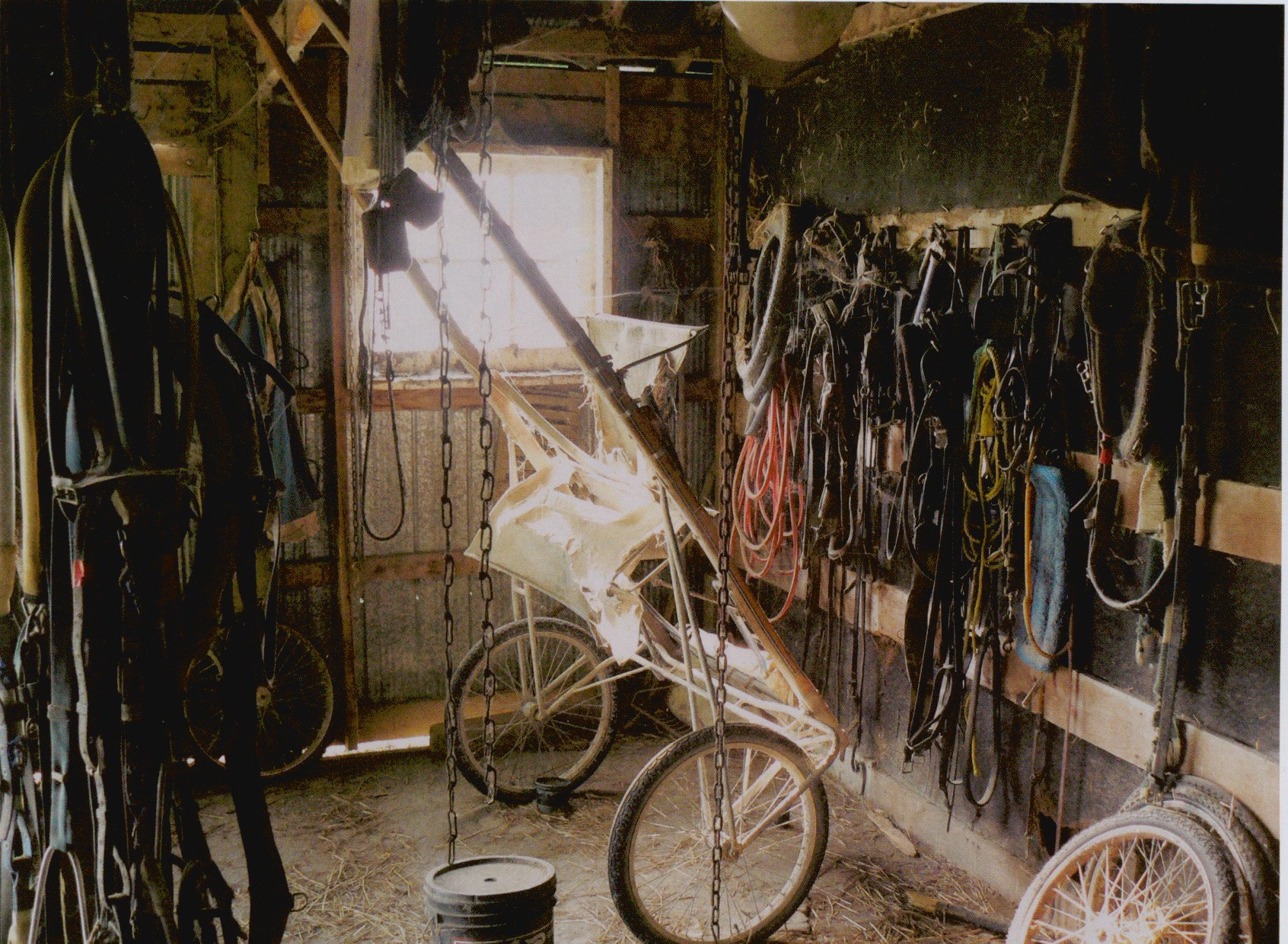
Jay's boyhood experience
Over the years, the horses became a sort of bonding exercise for Gord and his son, Jay. Jay's involvement in the business came early. “One summer day he called me, just before I was going to go to school at age six, and he said, 'you want to go to the races with Jack Ball this afternoon?' I said yes, I want to go. So he finished his work early that day and we went down to Greenwood in the Beaches. This would be about the summer of 1960.
"Jack hauled a horse in this truck, wooden sides, canvas top. We got the horse loaded in and they said, 'you get into the back and ride with the horse.'
“So this was just tremendously exciting. We went up to Toronto. I remember being in the back of that truck, and looking out the back door, and seeing the cars go by and people looking at me and boy, did I ever feel special, because I was in the back of that truck with that horse."
They arrived at the racetrack and the horse was unloaded. “It was still early, so we went over to Lake Ontario and took our shoes off and put our feet into the water on a really hot day. Then we went back and got the horse ready. But kids weren't allowed into the paddock.
"So Dad said, 'you go up into the grandstand and when the race is over, you come back down here.' So there I was six years old and he sends me off into the grandstand alone. You could do that in those days and it was safe. But to me it also said that there was a level of trust there from him that I wouldn’t get into trouble and that I would know how to handle myself if a situation came along.”
One incident that lies heavy on Gord occurred at Mohawk Raceway a few years ago. Jay had taken to racing standardbreds too, and drove many of Gord’s horses over the years. Gord and Jay had gone to watch one of his horses, Belgaum, which had just won a race and showed promise for the future. As the race progressed, Belgaum began to make his move, but there was a collision with another competitor. Belgaum, clearly in distress, pulled up and limped over the finish line.
Father and son took the horse immediately to the veterinary clinic at Guelph where they learned Belgaum had suffered a sliced tendon. He wasn’t even able to stand on the leg and had to be euthanized.
“We went from great excitement to total letdown. That was a long trip home,” Gord says. “The empty trailer. That took the wind out of Jay’s enthusiasm for racing horses. It was a crowded field. Those things happen.”
Jay continues the story. “We were back to the track the following week with another horse and arranged with the administration to look at the tape of the race.
“We could see what happened and it was obvious that Belgaum’s driver had made a mistake. The driver had run the horse right into the back end of another driver’s cart and the horse had to stop or else run into the driver in front of him. And in doing that he had injured himself. It was driver error.”
The dejected father and son stared at the replay. “Dad said ‘I know what happened now.’ We turned around and walked out and Dad said ‘that’s just one we’ve got to forget.’ There wasn’t any going to the driver and berating him for making a mistake. It’s just ‘that’s what happened.’ A mistake was made and it’s over and done with.
“Dad could deal with that and I couldn’t. I said ‘I just can’t take this horse business anymore, because you can never tell. There’s always a negative that comes after a positive. There’s just too much up and down. And I made a decision right there, I don’t want to be involved in this business anymore. It’s just too much heartache.
“For Dad he’d get over those things and carry on. He didn’t dwell on hard luck. He just accepted it and carried on.”
There is another lesson learned from Gord’s handling of the situation, too. In Jay’s words “it was honourable of him not to go back to the driver and make him relive that experience.”


